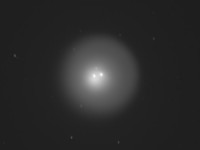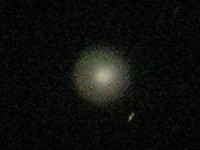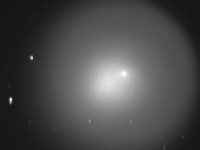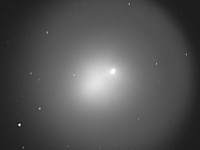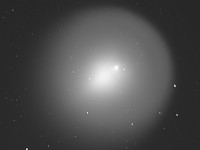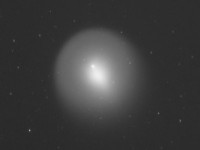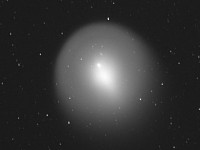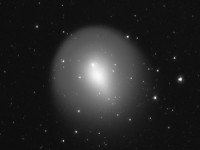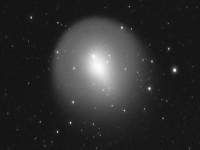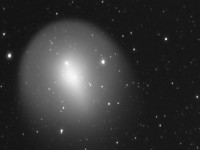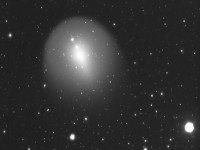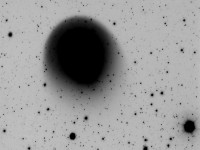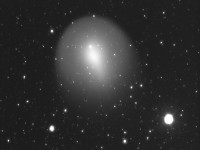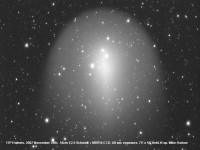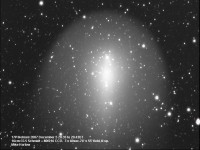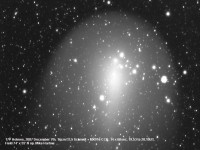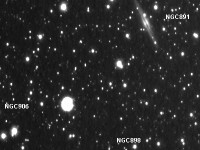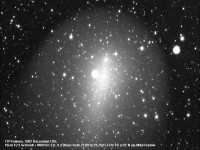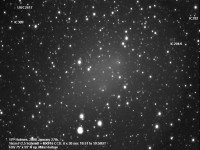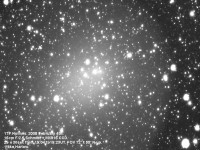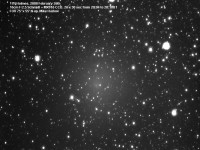Orwell Astronomical Society (Ipswich)
Comet 17P/Holmes, 27 October 2007 - 26 February 2008
Astronomers recovered periodic Comet Holmes (17P) in July 2007, shining as a faint object of magnitude circa 14.5. Very early in the morning of 24 October 2007, Spanish amateur astronomer Juan Antonio Henríquez Santana reported that the comet appeared to have undergone an outburst and was much brighter than expected. The comet continued to brighten during the next few hours, attaining a peak magnitude circa 2.7, easily visible to the naked eye close to α Persei (Mirphak). The BAA issued an electronic bulletin (no. 00313) in late afternoon of the day, alerting UK observers to the visibility of the comet.
Unfortunately, cloud covered the UK around the time of the outburst. However, by 27 October the cloud cleared and members of OASI began to report observations, summarised below. The comet appeared most unusual, with several observers commenting that it was like nothing that they had seen before. On 29 October, Jonathan Shanklin, Director of the Comet Section of the BAA, issued another electronic bulletin (no. 00314) encouraging astronomers to observe the comet - his text captures well the excitement of the occasion:
Comet Holmes is an amazing sight, showing several well-delineated concentric comae of decreasing brightness. It is likely to remain a prominent object for some time, and being circumpolar is visible all night. The coma diameter will probably continue to expand, and is already roughly a million kilometres across. Further outbursts may occur.
19:30
27 Oct 2007
Mike Harlow, Newbourne
Although the Moon was nearby the comet was clearly visible to the naked eye to the lower left of
α Persei. The comet was slightly fainter than the star, and through binoculars had the appearance of a pale yellow disc that was clearly non-stellar. Through a 200 mm Newtonian a stellar nucleus was visible with a slightly elongated coma and a large circular, sharply edged halo.
This is unlike any comet I have seen before and it will be well worth following over the coming weeks to see how it develops. If the weather permits I’ll try to image it once the Moon is out of the way.
00:10
29 Oct 2007
Mike Harlow, Newbourne
Finally a clear night! Got some nice images just after midnight 28-29 October with between 5 and 40 second exposures on my 34 cm F/4 Newtonian using a Starlight Xpress MX916 CCD.
The negative image is stretched (saturating the comet) to show the sharp edge to the outer halo, approximately 6 arcmin across, and the absence of a tail. Faintest stars in the image are about magnitude 14. North is to the right and the comet's motion is downward, to the west.
The positive image shows two background stars close to the cometary nucleus (the latter is the one on the right). The star of similar magnitude to its left is SAO 24247. I've stretched the image using a power 0.5 filter to bring out the fainter halo but keeping detail in the centre.
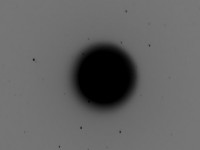 Negative image of coma.
Negative image of coma.
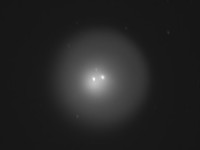 Comet close to two stars.
Comet close to two stars.
00:45
29 Oct 2007
James Appleton, East Ipswich
Observed the comet from home, using 10x50 binoculars, through some high level cloud. At first I couldn't recognise Perseus because the comet altered the shape of the constellation so much! In the binoculars the comet looked like the proverbial "dirty snowball" - a yellow round fuzzy object. Could see no tail.
18:45 - 19:05
29 Oct 2007
Ken Goward, Tuddenham
My family and I looked for and easily found Comet Holmes this evening from our back garden, which suffers from a street light right next to our boundary. To the naked eye it appeared as a very slight blur. In 7x50 binoculars it appeared as a pronounced yellow blur.
21:00
29 Oct 2007
Mike Whybray, Nacton
Comet Holmes was easy to find by eye with the aid of a star map. By eye I could detect a slight fuzziness about the comet - it just wasn't quite as sharp as the nearby stars. With 8x30 binoculars it was startling to see such an unfamiliar object, showing a clearly defined disc larger than any planet. No hint of a tail.
With a 114 mm aperture Newtonian and magnification of 90x there was again a clear circular disc. The outer edge was not completely sharp but it was amazingly well defined for a comet. I saw a slight additional brightness to the disc near the outer edge, and also a greater brightening at the centre. The central brightening seemed slightly offset (towards roughly the North) from a central brighter dot which I presume is the nucleus. I estimated the diameter of the comet by estimating the number of diameters required to step across the FoV of my telescope and comparing this to the size of the Moon viewed with the same eyepiece. The Moon occupied about 4/5ths of the width of the FoV, and the comet about 1/7th. I therefore calculated the diameter of the comet as: 30 arcmin * 1/0.8 * 1/7 = 5.4 armin.
21:00
29 Oct 2007
Mike Harlow, Newbourne
Image showing the diameter of the comet as approximately 6 arcmin. Taken with Starlight Xpress MX916 CCD and a 34 cm F/4.0 Newtonian.
21:20-21:50
29 Oct 2007
James Appleton, East Ipswich
Observing with Meade 250 mm SCT. There was some high altitude cloud but it was generally wispy so did not pose too much of a problem. The comet appeared roughly circular with an apparent diameter of 25% of the FoV of a 26 mm eyepiece (i.e. apparent diameter approx 8 arcmin). The E limb appeared well defined; the W limb rather less so. There was a central brightening, slightly offset towards the W, and a central star, roughly in the middle of the cometary disk. The star appeared separated from the brightest part of the central brightening at x100 but engulfed within it at x140 and x200. Another, fainter star was to the SE limb, inside the disk. No evidence of a tail.
Evening
30 Oct 2007
Pete Richards, Nicky Gillard & Paul Whiting, Orwell park Observatory
Nicky and Pete joined Paul at Orwell Park Observatory to see the comet. They identified it easily by naked eye. In binoculars it had the appearance of a very bright globular cluster. It appeared very interesting through the Tomline Refractor. Paul had hoped to image the comet with the webcam, but because of a race against time with an approaching cloud front was not able to do so.
18:30
30 Oct 2007
Mike Nicholls, Capel St. Mary
The comet was easily visible by naked eye, distorting the appearance of Perseus as others have noted. I was not aware of any fuzziness but those around me younger than I said it was obviously fuzzy. (The hazards of getting older!) The magnitude by naked eye seemed brighter than 3.0.
Had a look with 10x50 binoculars and a 200 mm reflector. In the binoculars the comet appeared simply as a fuzzy object and using the BAA comet section chart, I estimated the magnitude as 3.1. Using the reflector I again estimated the magnitude at 3.1 and noted some obvious structure. Two distinct areas seemed to stand out:
- A bright inner core. It was not perfectly circular but extended to one side, on which there was also a less defined edge.
- A less bright outer area, circular but with a less defined edge on the same side as that of 1. An attempt at a tail maybe?
19:53
30 Oct 2007
Martin Cook, East Ipswich
Image with Olympus C-765 camera, fixed mount, 8 second exposure, FL 63mm, ISO 400.
01:00
01 Nov 2007
Mike Harlow, Newbourne
Image showing the diameter of the comet as approximately 10 arcmin. This image has the same field of view as the image at 21:00 on 29 October, illustrating how the comet has expanded in just three days. The comet is now becoming asymmetric with a sharp edge to the North-East and a more diffuse edge on the opposite side.
Image details: Starlight Xpress MX916 CCD on a 34cm F/4.0 Newtonian. Field of view 23x17 arcmin.
20:11
01 Nov 2007
Mike Harlow, Newbourne
This is my best image so far of Comet Holmes, now that I’ve sorted out the collimation of my telescope. The comet is now almost 11 arcmin in diameter and is beginning to exhibit structure in the inner coma. A very low contrast jet or tail can be seen extending from the nucleus towards lower left within the coma.
Image details: 30 second exposure with Starlight Xpress MX916 CCD on a 34cm F/4.0 Newtonian. Field of view 23x17 arcmin. North to the right.
23:31
04 Nov 2007
Mike Harlow, Newbourne
Holmes continues to expand and is now close to filling the field of view of my CCD on the 34 cm Newtonian. I estimate from the following image that it is approximately 15 arcmin in diameter. I haven’t attempted any magnitude estimates but to the naked eye it does appear to be slowly fading and the surface brightness as seen through the telescope is definitely less than it was a week ago when I took my first image.
Image details: 30 second exposure with Starlight Xpress MX916 CCD on a 34 cm F/4.0 Newtonian. Field of view 23x17 arcmin.
21:21
06 Nov 2007
Mike Harlow, Newbourne
Now that Holmes is bigger than the field of view of my Newtonian telescope I’ve switched to imaging with my Schmidt camera which has a much larger field of view. After a nice clear day the clouds rolled in as it got dark so the only images I captured were rather washed out. The best of the bunch is below. It captures stars of magnitudes down to 14 and shows Holmes to have a diameter of approximately 18 arcmin.
Image details: 60 second exposure with 16 cm F/2.5 Schmidt and Starlight Xpress MX916 CCD. Field of view 72x56 arcmin.
Evening
07 Nov 2007
James Appleton, Nacton Village Hall
Approximately 20 members of OASI enjoyed views of Comet Holmes through the OASI Millennium Telescope (48 cm Dobsonian) and a variety of binoculars at Nacton Village Hall. The following limb of the cometary disk appeared well defined, and the leading limb very ragged. Using averted vision there was a hint that the central condensation was becoming elongated along an E-W axis. There may also have been a hint of a tail developing from the leading limb? With low-power binoculars, the diameter of the comet appeared similar to the separation between Alcyone and Merope, circa 19.5 arcmin.
22:21
08 Nov 2007
Mike Harlow, Newbourne
Despite the strong winds I managed to capture more images of Comet Holmes. Measured across the extended coma, perpendicular to the "tail", the comet now has a diameter of approximately 21 arcmin. It is still expanding and should be as big as the full moon by the middle of next week!
Image details: 60 second exposure with 16 cm F/2.5 Schmidt and Starlight Xpress MX916 CCD. Field of view 72x56 arcmin.
21:19
11 Nov 2007
Mike Harlow, Newbourne
Got a few images before the rain started falling on the laptop! Estimated diameter of the extended coma is ~26 arcmin.
Image details: 60 second exposure with 16 cm F/2.5 Schmidt and Starlight Xpress MX916 CCD.
23:45
11 Nov 2007
James Appleton, East Ipswich
Observed Comet Holmes with 10x50 binoculars. The sky was exceptionally still and transparent, having been washed clean by rain earlier in the evening. An elongated central condensation was visible at the centre of the coma. Estimated the diameter of the comet by comparison with the separation between the stars in the Hipparcos catalogue H16244 (34 Per) and H16147: estimated diameter 30 arcmin.
00:32
12 Nov 2007
Mike Harlow, Newbourne
Having dried off the laptop and waited for about three hours I looked out again to find a perfectly clear sky. I tried again for another long series of images for stacking later. The image below was taken 3 hours and 13 minutes after the image above on 11 November. The two images clearly show the motion of the comet.
If you download the full images, shrink them to an appropriate size and arrange them side by side one in front of each eye, you may be able to obtain a 3-D effect whereby the comet appears to hang in space in front of the stars. Interestingly if you get the pictures the wrong way round the comet appears behind the stars!
Image details: 16 cm F/2.5 Schmidt and Starlight Xpress MX916 CCD.
22:15
14 Nov 2007
Mike Harlow, Newbourne
Holmes is now in the same field of view of my camera as
α Persei. I imaged them between bands of cloud that repeatedly came and went.
Image details: 16 cm F/2.5 Schmidt and Starlight Xpress MX916 CCD.
19:46
15 Nov 2007
Mike Harlow, Newbourne
Another clear(ish) night - Holmes through binoculars was spectacular in the same field as
α Persei. Below: a modestly stretched positive image and a very stretched negative image bring out the shape of the comet.
Image details: 16 cm F/2.5 Schmidt and Starlight Xpress MX916 CCD.
21:35
16 Nov 2007
Mike Harlow, Newbourne
The last Holmes image for some days due to the reappearance of the Moon and poor weather.
19:42
29 Nov 2007
Mike Harlow, Newbourne
Holmes appears significantly fuzzier, and bigger, than when last imaged on 16 November.
20:35
05 Dec 2007
Mike Harlow, Newbourne
Holmes continues to get bigger and fainter and is still well worth observing. I’m rapidly running out of space in my field of view so will have to start mosaicing pictures soon!
19:53
07 Dec 2007
Mike Harlow, Newbourne
Despite windy conditions it was possible to image Holmes again. The comet continues to grow but appears to be developing a more typical comet shape deep inside the extended dust halo.
11 Dec 2007
Mike Harlow, Newbourne
Holmes is in the vicinity of the well-known spiral galaxy NGC891.
21:09
12 Dec 2007
Mike Harlow, Newbourne
I managed to image Comet Holmes before patchy cloud rolled in from the sea. The comet is still easily visible to the naked eye from a dark site when overhead as it was when I took the image below. This could be the last image for a while, as the combination of cloudy weather, the reappearance of the Moon and a large tree(!) could make imaging difficult for the next few weeks.
Image details: 16 cm F/2.5 Schmidt camera with Starlight Xpress MX916 CCD, 9x30 second exposures from 21:09 to 21:25 UT. FoV 75x55 arcmin.
19:55
27 Jan 2008
Mike Harlow, Newbourne
My first look at Comet Holmes in 2008! It is now very large and very diffuse so the image only covers the central region. There was no time for a mosaic as patchy cloud kept rolling in to spoil the view. Several faint galaxies are visible in the image, IC292, IC309 and IC294 are between 14
th and 15
th magnitude. The fuzzy patches towards the middle of the image are probably ghost images as no galaxies are catalogued in that area.
Image details: 16 cm F/2.5 Schmidt camera with Starlight Xpress MX916 CCD, 6x30 second exposures from 19:51 to 19:58 UT. FoV 75x55 arcmin. North up.
20:10
04 Feb 2008
Mike Harlow, Newbourne
Holmes now has a very low surface brightness. I couldn’t see it with the naked eye or through the 100 mm finder but I wasn’t properly dark adapted at the time. The leading edge is still reasonably well defined but the rest of the comet is very diffuse. Holmes forms a line across the sky with
comet C2008 C1 (Chen-Gao) near M52 in western Cassiopeia and
comet 29P/Schwassmann-Wachmann south of M37. The objects are in order of increasing distance from Earth too: Chen-Gao (the faintest!) at 1.47 AU, Holmes at 2.5 AU and SW1 at 5.3 AU.
Image details: 16 cm F/2.5 Schmidt camera with Starlight Xpress MX916 CCD, 29x30 second exposures from 19:04 to 19:23 UT. FoV 72x55 arcmin. North up.
20:10
26 Feb 2008
Mike Harlow, Newbourne
Holmes is still visible but the outer halo is now far too big and faint for me to image with my equipment and only the inner region is shown in the image below. While I was out I thought I would also image a well known deep sky object which I hadn't attempted before:
IC434, the Horsehead Nebula.
Image details: 16 cm F/2.5 Schmidt camera with Starlight Xpress MX916 CCD, 26x30 second exposures from 20:04 to 20:18 UT. FoV 75x55 arcmin. North up.
James Appleton


